AC Transit
AC Transit (Alameda-Contra Costa Transit District) is an Oakland-based public transit agency serving the western portions of Alameda and Contra Costa counties in the East Bay of the San Francisco Bay Area. AC Transit also operates "Transbay" routes across San Francisco Bay to San Francisco and selected areas in San Mateo and Santa Clara counties. AC Transit is constituted as a special district under California law. It is governed by seven elected members (five from geographic wards and two at large). It is not a part of or under the control of Alameda or Contra Costa counties or any local jurisdictions.
_cropped.svg.png) | |
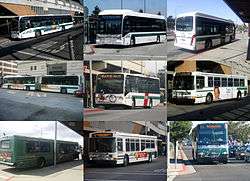 A collage of AC Transit's buses | |
| Founded | 1960 |
|---|---|
| Headquarters | 1600 Franklin St, Oakland, CA |
| Locale | East Bay |
| Service area | Western Alameda and Contra Costa counties |
| Service type | bus service |
| Routes | 147[1] |
| Stops | approx. 5,500[2] |
| Fleet | 630[2] |
| Daily ridership | approx. 178,851 ridership per year = approx. 55 million[2] |
| Operator | Alameda-Contra Costa Transit District |
| Chief executive | Mike Hursh, General Manager |
| Website | actransit.org |
Buses operate out of four operating divisions: Emeryville, East Oakland (Seminary), Hayward, and Richmond. The Operations Control Center is in Emeryville.[2] The Richmond operating division closed in 2011,[3] but opened again in early 2017 due to a revived economy.[4] The District is the public successor to the privately owned Key System.
Service area
The District encompasses the following cities and unincorporated areas: Oakland, Fremont, Hayward, Berkeley, Richmond, San Leandro, Alameda, Castro Valley, Newark, San Pablo, El Cerrito, San Lorenzo, Ashland, Albany, Cherryland, El Sobrante, Piedmont, Fairview, Emeryville, Kensington, and East Richmond Heights. The District's bus lines also serve parts of some other East Bay communities, including Milpitas, Pinole, and Union City.
AC Transit serves many colleges and universities including the University of California, Berkeley; Stanford University; California State University, East Bay; Chabot College; Holy Names University; Peralta Colleges (Laney College, College of Alameda, Berkeley City College, and Merritt College), Contra Costa College; Ohlone College; Northwestern Polytechnic University; and Mills College.
Most routes connect with regional train service, primarily BART (Bay Area Rapid Transit), in addition to ACE and Amtrak, including (among other trains) the Capitol Corridor. AC Transit routes also connect with several other regional transit services, including Union City Transit, SamTrans, WestCAT, the Santa Clara Valley Transportation Authority (VTA), San Francisco Municipal Railway (Muni), Golden Gate Transit, the Alameda-Oakland Ferry, the Harbor Bay Ferry, Emery Go Round, SolTrans and FAST.
While most AC Transit service consists of local lines throughout the East Bay, the District also provides many Transbay lines. Most of these run across the San Francisco–Oakland Bay Bridge to connect communities as distant as El Sobrante and Newark with San Francisco's Transbay Terminal (formerly the terminus of the Key System). Bus service is also provided across the San Mateo and Dumbarton bridges to the south.
Hubs
AC Transit's primary hubs include BART stations, major shopping centers, and points of interest, which are spread throughout the East Bay. Most routes serve and/or terminate at BART stations. The hubs include:
|
|
Routes
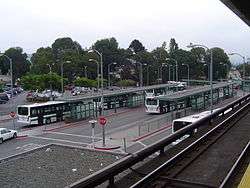
Much of AC transit's ridership is skewed heavily towards a few heavily-trafficked local (as opposed to trans-bay) routes. As of 2013, the top five routes account for a third of all riders, and the top twelve routes account for more than half.[5]
Timeline
Voters created the Alameda-Contra Costa Transit District (AC Transit) in 1956 and subsequently approved a $16.5 million bond issue in 1959 enabling the District to buy out the failing privately owned Key System Transit Lines. In October 1960, AC Transit’s service began. The new District built up the bus fleet with 250 new “transit liner” buses, extended service into new neighborhoods, created an intercity express bus network, and increased Bay Bridge bus service.[6]
In 2003, the District introduced a San Mateo-Hayward Bridge route. Designated as Line M, the service connected the BART stations of Castro Valley and Hayward with Foster City and San Mateo's Hillsdale Caltrain station. A second San Mateo-Hayward Bridge route, Line MA, was added in 2006 and discontinued in 2007. (The M replaced the SamTrans 90E, which had been canceled in 1999.)
On June 30, 2003, a new "rapid bus" line operating on San Pablo Avenue was introduced. Designated as Line 72R (or San Pablo Rapid), the service connected Oakland with Richmond and operated at faster speeds than regular local service due to wide stop spacing and signal priority treatments.
In 2004, the District began service on Line U across the Dumbarton Bridge, connecting Stanford University with ACE and BART trains in Fremont. As part of a consortium of transit agencies (including AC Transit, BART, SamTrans, Union City Transit, and VTA), the District already operated Dumbarton Express bus service across the Dumbarton Bridge.
Beginning December 10, 2005, AC Transit began participating in the regional All Nighter network, providing 24-hour bus service throughout its service area to supplement BART service, which does not operate during owl hours. AC Transit had provided 24-hour service on many of its trunk lines prior to this date, except in the late 1990s due to budget limitations.
On July 30, 2007, AC Transit announced that it had entered into a 25-year partnership with SunPower, MMA Renewable Ventures, and PG&E to install solar energy systems at its facilities in an effort to reduce its carbon footprint, improve local air quality, and save money on energy costs that could be used instead to spend on transit service.[7]
On March 28, 2010, several major service changes were implemented to reduce a severe budget shortfall. Changes included reduced service on local and Transbay lines, elimination of unproductive routes, splitting of the 51 into two sections (called as lines "51A" and "51B"), and the introduction of limited-stop line 58L (which, as of 2016, is discontinued).[8][9]
Starting in February 2011, all buses on Line 376 were being escorted by a marked Contra Costa County Sheriff's patrol vehicle through the unincorporated community of North Richmond. Line 376 provides late-night service through North Richmond and the nearby cities of Richmond, San Pablo, and Pinole. The escorts were introduced to improve the safety of the service, which had five serious incidents between 5 January and 9 February.[10]
On December 13, 2013, AC Transit adopted a new fare policy that brought changes to the transit system July 2014, including a new day pass that is in line with other transit agencies including VTA and SamTrans.[11] The policy is also designed to speed boarding and help keep buses on schedule, provide greater convenience and value for customers, and encourage more customers to switch to Clipper[12]
Rapid Bus and Bus Rapid Transit
Line 72R | |||||||||||||||||||||||||||||||||||||||||||||||||||||||||||||||||||||||||||||||||||||||||||||||||||||||||||||||||||||||||||||||||||||||||||||||||||||||||||||||||||||||||||||||||||||||||||||||||||||||||||||||||||||||||||||||||||||||||||||||||||||||||||||||||||||
|---|---|---|---|---|---|---|---|---|---|---|---|---|---|---|---|---|---|---|---|---|---|---|---|---|---|---|---|---|---|---|---|---|---|---|---|---|---|---|---|---|---|---|---|---|---|---|---|---|---|---|---|---|---|---|---|---|---|---|---|---|---|---|---|---|---|---|---|---|---|---|---|---|---|---|---|---|---|---|---|---|---|---|---|---|---|---|---|---|---|---|---|---|---|---|---|---|---|---|---|---|---|---|---|---|---|---|---|---|---|---|---|---|---|---|---|---|---|---|---|---|---|---|---|---|---|---|---|---|---|---|---|---|---|---|---|---|---|---|---|---|---|---|---|---|---|---|---|---|---|---|---|---|---|---|---|---|---|---|---|---|---|---|---|---|---|---|---|---|---|---|---|---|---|---|---|---|---|---|---|---|---|---|---|---|---|---|---|---|---|---|---|---|---|---|---|---|---|---|---|---|---|---|---|---|---|---|---|---|---|---|---|---|---|---|---|---|---|---|---|---|---|---|---|---|---|---|---|---|---|---|---|---|---|---|---|---|---|---|---|---|---|---|---|---|---|---|---|---|---|---|---|---|---|---|---|---|---|---|---|---|---|
| |||||||||||||||||||||||||||||||||||||||||||||||||||||||||||||||||||||||||||||||||||||||||||||||||||||||||||||||||||||||||||||||||||||||||||||||||||||||||||||||||||||||||||||||||||||||||||||||||||||||||||||||||||||||||||||||||||||||||||||||||||||||||||||||||||||
East Bay BRT | ||||||||||||||||||||||||||||||||||||||||||||||||||||||||||||||||||||||||||||||||||||||||||||||||||||||||||||||||||||||||||||||||||||||||||||||||||||||||||||||||||||||||||||||||||||||||||||||||||||||||||||||||||||||||||||||||||||||||||||||||||||||||||||||||||||||||||||||||||||||||||||||||||||||||
|---|---|---|---|---|---|---|---|---|---|---|---|---|---|---|---|---|---|---|---|---|---|---|---|---|---|---|---|---|---|---|---|---|---|---|---|---|---|---|---|---|---|---|---|---|---|---|---|---|---|---|---|---|---|---|---|---|---|---|---|---|---|---|---|---|---|---|---|---|---|---|---|---|---|---|---|---|---|---|---|---|---|---|---|---|---|---|---|---|---|---|---|---|---|---|---|---|---|---|---|---|---|---|---|---|---|---|---|---|---|---|---|---|---|---|---|---|---|---|---|---|---|---|---|---|---|---|---|---|---|---|---|---|---|---|---|---|---|---|---|---|---|---|---|---|---|---|---|---|---|---|---|---|---|---|---|---|---|---|---|---|---|---|---|---|---|---|---|---|---|---|---|---|---|---|---|---|---|---|---|---|---|---|---|---|---|---|---|---|---|---|---|---|---|---|---|---|---|---|---|---|---|---|---|---|---|---|---|---|---|---|---|---|---|---|---|---|---|---|---|---|---|---|---|---|---|---|---|---|---|---|---|---|---|---|---|---|---|---|---|---|---|---|---|---|---|---|---|---|---|---|---|---|---|---|---|---|---|---|---|---|---|---|---|---|---|---|---|---|---|---|---|---|---|---|---|---|---|---|---|---|---|---|---|---|---|---|---|---|---|---|---|---|---|---|---|---|
Not yet in operation | ||||||||||||||||||||||||||||||||||||||||||||||||||||||||||||||||||||||||||||||||||||||||||||||||||||||||||||||||||||||||||||||||||||||||||||||||||||||||||||||||||||||||||||||||||||||||||||||||||||||||||||||||||||||||||||||||||||||||||||||||||||||||||||||||||||||||||||||||||||||||||||||||||||||||
| ||||||||||||||||||||||||||||||||||||||||||||||||||||||||||||||||||||||||||||||||||||||||||||||||||||||||||||||||||||||||||||||||||||||||||||||||||||||||||||||||||||||||||||||||||||||||||||||||||||||||||||||||||||||||||||||||||||||||||||||||||||||||||||||||||||||||||||||||||||||||||||||||||||||||
A rapid bus line was introduced on San Pablo Avenue on June 30, 2003. Designated as Line 72R (or San Pablo Rapid), it operates from 6 am to 7 pm at 12-minute intervals on weekdays, and 7 am to 7 pm at 15-minute intervals on weekends and holidays. Bus stops are spaced 2/3-mile apart on average, running between Jack London Square (via 20th Street and Broadway) in Oakland and Contra Costa College in San Pablo, and buses receive signal priority at several intersections. Although the line does have scheduled timepoints en route, most buses typically travel along the route as fast (or as slow) as traffic allows.
On June 24, 2007, the success of line 72R made it a model for another rapid bus line that was introduced.[13][14] Line 1R (or International Rapid) operated on weekdays between Berkeley Way and Oxford Street in Berkeley and Bay Fair BART station, mainly along Telegraph Avenue, International Boulevard, and East 14th Street. Weekend and holiday service operated between downtown Oakland and San Leandro only.
Line 1R was eliminated on June 26, 2016. AC Transit is currently constructing a Bus Rapid Transit line along International Blvd.[15] AC Transit’s Bus Rapid Transit (BRT) project will operate between Uptown Oakland and San Leandro. Approved in 2012 by both cities, BRT will feature level boarding, pre-paid ticketing, and dedicated transit lanes along much of the corridor. The project is funded by Alameda County Measure B, the Metropolitan Transportation Commission, the State of California, and the Federal Transit Administration. The project broke ground in August 2016[16] and is expected to begin revenue service in summer 2020.[17] There are no plans for bus rapid transit along the Telegraph Avenue alignment of the 1R; the section between uptown Oakland and U.C. Berkeley is mostly served by present-day local line 6.
Bus fleet
At its inception, AC Transit purchased the mixed White, Mack, and GM "old-look" bus fleet from its predecessor, the Key System. The ex-Key System buses were repainted in "clownface" livery, featuring a predominantly white (upper half) and orange (lower front) color scheme with teal side stripes, and AC Transit adopted a "wing" logo featuring the same colors. After its inception, the first new AC Transit orders were for GM New Look buses, which the agency advertised as "Transit Liners". AC Transit began New Look operation in late 1960.[18] AC Transit would continue to operate a mixed fleet of buses throughout the 1960s.
.jpg) Key System #1860 with color-block livery
Key System #1860 with color-block livery.jpg) AC Transit #1811 purchased from Key System, repainted in "clownface" white and orange livery, featuring wing logo
AC Transit #1811 purchased from Key System, repainted in "clownface" white and orange livery, featuring wing logo.jpg) AC Transit first-generation (TDH-5301) 40-ft GM New Look bus fleet in "clownface" and wing logo
AC Transit first-generation (TDH-5301) 40-ft GM New Look bus fleet in "clownface" and wing logo
AC Transit also pioneered the use of articulated buses in the United States; in March 1966 it was the first transit agency to use the Super Golden Eagle long-distance coach (originally designed and built for Continental Trailways; AC Transit designated it XMC-77 and called it the "Freeway Train"), primarily on Transbay service.[19] By 1970, AC Transit was one of six agencies to participate in a "super bus project" coordinated by the National Transportation Center (Pittsburgh) to write a specification for a higher-capacity bus; once the specification had been written, two prototypes would be built and tested to select a winner for a large group procurement of 100 buses to keep per-unit costs low.[20] Two European-built articulated buses were tested in the summer of 1974: a Volvo B58, and a MAN SG 192.[21][22] Riders received the M.A.N. bus favorably, and the specification was released for bid in 1975;[23] AC Transit placed an order for 30 buses in 1976 and deliveries began from the AM General/M.A.N. joint venture in 1978.[24]
.jpg) AC Transit XMC-77, the "Freeway Train" (c.1966)
AC Transit XMC-77, the "Freeway Train" (c.1966).jpg) MAN SG 192 articulated bus during 1974 testing
MAN SG 192 articulated bus during 1974 testing.jpg) GM New Look (#314) and MAN SG 220 (#1629) in traffic with matching "clownface" livery
GM New Look (#314) and MAN SG 220 (#1629) in traffic with matching "clownface" livery
For its rigid buses, AC Transit continued purchasing GM New Look buses through the early 1970s, then switched to purchasing Flxible New Look buses starting in 1974. Since the early 1980s, AC Transit began acquiring buses from Flyer, Neoplan, and Gillig. Around this time, AC Transit began ordering new buses in a "stripe" color scheme, featuring the same orange, teal, and white colors as the previous "clownface" livery. In the late 1990s, AC Transit added buses from NABI.[25] AC Transit supplemented these buses with a fleet of 45-foot over-the-road coaches purchased from Motor Coach Industries beginning in the early 2000s.
In 2003, AC Transit began purchasing low-floor buses from Van Hool. The Van Hool buses were assembled in Belgium and featured low floors and three doors (four doors on articulated models), which AC Transit touted as the key to bus rapid transit service between Berkeley and San Leandro along Shattuck, Telegraph, International Blvd, and East 14th Street.[26] At the same time, AC Transit rolled out a revised "stripe" livery featuring new colors (green and black), and a new logo.[27] The logo was simplified in 2014.[28]
.jpg) Flyer D901 fleet with "clownface" livery similar to the New Looks
Flyer D901 fleet with "clownface" livery similar to the New Looks- NABI 416 with 1980s "stripe" livery and wing logo
- NABI 40-LFW with updated 2003 stripe livery, colors, and logo
After criticism over the use of federal funds to purchase foreign-made Van Hool buses and the tailoring of specification requirements to exclude domestic manufacturers,[29] AC Transit ordered locally-built Gillig buses in 2012.[30] In March 2013, AC Transit began operating the first of its new Gillig buses.[31] In August of the same year, AC Transit placed the first of its new New Flyer Xcelsior articulated buses into service.[32] Later that year, in November 2013, new Gillig buses with a suburban seating configuration and Transbay branding were introduced into service.[33]
- MCI suburban coaches are primarily finished in green.
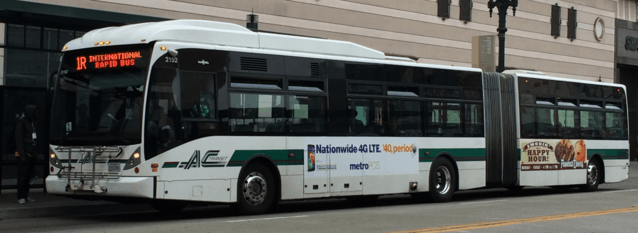 AC Transit #2152, Van Hool AG300 articulated in white with updated 2003 stripe livery (2012)
AC Transit #2152, Van Hool AG300 articulated in white with updated 2003 stripe livery (2012)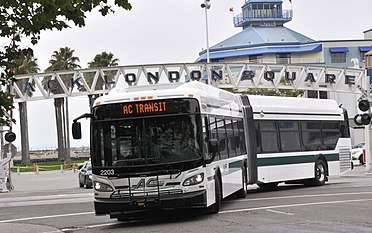 AC Transit #2203, a New Flyer XD60, at Jack London Square on 5 June 2013
AC Transit #2203, a New Flyer XD60, at Jack London Square on 5 June 2013
All AC Transit buses are wheelchair accessible and have front-mounted bicycle racks. The MCI buses also feature luggage bay bicycle racks. AC Transit buses purchased after 2007 have air conditioning, as approved by the Board of Directors.[34]
Alternative power
In 1969, AC Transit received a grant and converted bus #666 to steam power, which ran in revenue service between 1971 and 1972. The propulsion system was designed by William Brobeck and used a triple-expansion reciprocating steam engine; power was improved compared to the original six-cylinder Detroit Diesel 6V71 engine and emissions were reduced, but fuel consumption was higher than the conventional diesel bus.[35] The steam system is a closed loop. Exhaust steam is condensed and returned to the steam generator, which is an externally-fired boiler that uses 1,400 feet (430 m) of coiled steel tubing.[36] Prior to entering service, the steam bus was exhibited in Washington DC[37] and to the public.[38] Bus #666 completed 3,403 miles (5,477 km) in revenue service when the trial ended in September 1972,[39] and the diesel engine was subsequently reinstalled in the bus.[40]
AC Transit is the lead agency of Zero Emission Bay Area (ZEBA), a consortium of five Bay Area transit agencies (AC Transit, Golden Gate Transit, SFMTA, SamTrans, and VTA) demonstrating fuel cell buses.[41] The District began the HyRoad program in 1999 and tested several fuel cell buses with new hydrogen fuelling infrastructure, including the Ballard/XCELLSiS ZEbus (a New Flyer F40LF with a Ballard fuel cell) in November 1999.[42] Three hydrogen-powered buses, based on the Van Hool A330, operated in revenue service from 2006 to 2010. AC Transit took delivery of 12 additional third-generation fuel cell buses, based on the Van Hool A300L in 2011. In 2019, AC Transit began operating 11 additional hydrogen fuel cell buses from New Flyer, one of which is a 60-foot articulated bus, and 5 battery electric buses from New Flyer.[43]
Active fleet
| Year | Manufacturer | Model | Length (feet) |
Quantity | Fleet Series | Fuel | Image |
|---|---|---|---|---|---|---|---|
| 2003 | MCI | D4500 | 45 | 39 | 6041-6079 | Diesel | |
| Van Hool | A330 | 40 | 98 | 1001-1110 | |||
| 2006 | Van Hool | A300K | 30 | 51 | 5001-5051 | Diesel | 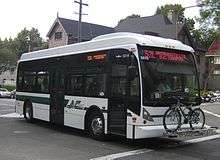 |
| 2007 | Van Hool | AG300 | 60 | 10 | 2101-2110 | Diesel | |
| 60 | 14 | 2151-2165 | |||||
| 2008 | Van Hool | A300L | 40 | 27 | 1201-1227 | Diesel | 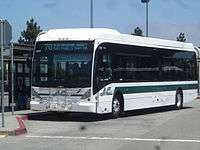 |
| A300K | 30 | 39 | 5101-5139 | Diesel | |||
| 2010 | Van Hool | AG300 | 60 | 9 | 2191-2199 | Diesel | |
| A300L FC | 40 | 12 | FC4-FC16 | Hydrogen | |||
| 2013 | Gillig | Low Floor | 40[44] | 65 | 1301-1365 | Diesel | |
| New Flyer | Xcelsior XD60[32] | 60 | 23 | 2201-2223 | Diesel | ||
| Gillig | Low Floor | 40[45] | 54 | 6101-6155 | Diesel | .png) | |
| 2014 | Gillig | Low Floor | 40 | 68 | 1401-1468 | Diesel | |
| 2015 | ElDorado National | Aerotech 220 | 24 | 10 | 3501-3510 | Diesel |  |
| 2016 | Gillig | Low Floor | 40 | 55 | 1501-1555 | Diesel | |
| Gillig | Low Floor[46] | 40 | 25 | 1556-1580 | Diesel-Electric Hybrid | ||
| 2017 | Gillig | Low Floor | 40 | 10 | 1581-1590 | Diesel | |
| 2018 | Alexander Dennis | Enviro500 | 42 | 15 | 6201-6215 | Diesel |  |
| New Flyer | Xcelsior XD60 | 60 | 29 | 2224-2252 | Diesel | ||
| 2019 | Gillig | Low Floor | 40 | 1 | 1591 | Diesel-Electric Hybrid | |
| Gillig | Low Floor | 40 | 35[43] | 1601-1635 | Diesel | ||
| New Flyer | Xcelsior XDE60 (BRT model) |
60 | 27[43] | 2301-2327 | Diesel-Electric Hybrid |  | |
| New Flyer | Xcelsior XHE40 | 40 | 10[43] | 7017-7026 | Hydrogen Fuel Cell |  | |
| New Flyer | Xcelsior XE40 | 40 | 5[43] | 8001-8005 | Battery Electric |  | |
| New Flyer | Xcelsior XHE60 | 60 | 1[43] | Hydrogen Fuel Cell (pilot program) |
Future Fleet
| Year | Manufacturer | Model | Length (feet) |
Quantity | Fleet Series | Fuel | Image | Notes |
|---|---|---|---|---|---|---|---|---|
| 2020-2024 | MCI | D45 CRT LE [47] | 45 | 137 (50 to be used by AC Transit) | TBD | Diesel | ||
Retired fleet
| Year | Manufacturer | Model | Length (feet) | Quantity | Fleet Series | Fuel | Image |
|---|---|---|---|---|---|---|---|
| 1941–42 | White | 788[lower-alpha 1] | 33 | 23 | 815-898[lower-alpha 2] | Gasoline | .jpg) |
| 1944–45 | White | 798[lower-alpha 1] | 35 | 91 | 900-999[lower-alpha 3] | Gasoline | |
| 1947–48 | White | 798[lower-alpha 1] | 35 | 75 | 1000-1074 | Gasoline | |
| 1946 | GM | TGM-3609 Old Look[lower-alpha 1] | 30' 9" | 45 | 1300-1344 | Gasoline[lower-alpha 4] | |
| 1946 | GM | TGM-3609 Old Look[lower-alpha 1] | 30' 9" | 20 | 1200-1241 | Diesel[lower-alpha 5] | |
| 1947 | GM | TDH-4008 Old Look[lower-alpha 1][lower-alpha 6] | 33 | 5 | 1401-1405 | Diesel | .jpg) |
| 1944 | GM | TD-4006 Old Look[lower-alpha 7] | 33 | 5 | 1500-1504 | Diesel | |
| 1940–41 | GM | TD-4001 Old Look[lower-alpha 8] | 33 | 5 | 1501-1504 | Diesel | |
| 1947–48 | GM | TDH-4507 Old Look[lower-alpha 1][lower-alpha 6] | 35 | 175 | 1700-1875[lower-alpha 9] | Diesel | .jpg) |
| 1949 | GM | TDH-4509 Old Look[lower-alpha 1] | 35 | 25 | 1900-1924 | Diesel | .jpg) |
| 1950–51 | GM | TDH-5103 Old Look[lower-alpha 1] | 39' 6" | 50 | 2000-2049 | Diesel | |
| 1958 | GM | TDH-4801 Old Look[lower-alpha 1] | 37' 6" | 21 | 2100-2120 | Diesel | .jpg) |
| 1947 | Mack | C-41-GT[lower-alpha 1] | 33' 2" | 60 | 2501-2560 | Gasoline | .jpg) |
| 1960–61 | GM | SDH-4501 New Look | 35 | 57 | 100-156 | Diesel | .jpg) |
| 1961 | GM | SDM-4501 New Look | 35 | 5 | 300-304[lower-alpha 10] | Diesel | |
| 1961 | GM | TDH-4516 New Look | 35 | 50 | 400-449 | Diesel | .jpg) |
| 1961 | GM | TDH-5301 New Look | 40 | 125 | 500-624 | Diesel[lower-alpha 11] | .jpg) |
| 1961–62 | GM | TDH-4517 New Look | 35 | 43 | 700-712; 720-749 | Diesel | .jpg) |
| 1963–66 | GM | TDH-5304 New Look | 40 | 65 | 300-364 | Diesel | _(cropped).jpg) |
| 1963–66 | GM | TDH-4519 New Look | 35 | 55 | 750-804 | Diesel | _(cropped).jpg) |
| 1968–69 | GM | T6H-5305 New Look | 40 | 55 | 626-680 | Diesel | .jpg) |
| 1968 | GM | T6H-4532 New Look | 35 | 5 | 805-809 | Diesel | |
| 1971–72 | GM | T6H-5305 New Look | 40 | 90 | 900-989 | Diesel[lower-alpha 12] | .jpg) |
| 1973 | GM | T6H-5307N New Look | 35 | 55 | 810-864 | Diesel[lower-alpha 12] | .jpg) |
| 1961 (1974) | GM | TDH-4517 New Look | 29 | 13 | 700S-712S[lower-alpha 13] | Diesel | .jpg) |
| 1974 | Flxible | 53102 New Look | 40 | 120 | 180-299 | Diesel | .jpg) |
| 1975 | Flxible | 53102 New Look | 40 | 36 | 8000-8035[lower-alpha 14] | Diesel | .jpg) |
| 1976 | Minibus | MBD-8002 | 25 | 29 | 2200-2228 | Diesel | .jpg) |
| 1978 | M.A.N. | SG 220 | 60 articulated | 30 | 1600-1629 | Diesel | _(cropped).jpg) |
| 1980–82 | Flyer | D901[lower-alpha 15] | 40 | 170 | 1000-1169 | Diesel | .jpg) |
| 1980 | Flyer | D901[lower-alpha 15] | 35 | 155 | 2000-2019 | Diesel | |
| 1982–84 | Gillig | Phantom | 40 | 226 | 1300-1390; 1400-1483; 1485; 1500-1549[lower-alpha 16] | Diesel | .jpg) |
| 1982–83 | Gillig | Phantom | 35 | 51 | 2049-2099 | Diesel | |
| 1983 | Neoplan | AN440 | 40 | 61 | 1200-1260 | Diesel | |
| 1984 | Neoplan | AN408 | 26 | 3 | 2300-2302 | Diesel | |
| 1983 | M.A.N. | SG 310 | 60 articulated | 15 | 1630-1644[lower-alpha 17] | Diesel | .jpg) |
| 1983 | Crown-Ikarus | 286 | 60 articulated | 15 | 1700-1714[lower-alpha 17] | Diesel | |
| 1988 | New Flyer | D35HF | 35 | 29 | 2400-2428 | Diesel | .jpg) |
| 1988–89 | New Flyer | D40HF | 40 | 79 | 2500-2578 | Diesel | .jpg) |
| 1989 | New Flyer | D60HF | 60 articulated | 30 | 1800-1829 | Diesel | |
| 1990 | Gillig | Phantom | 40 | 52 | 2601-2652 | Diesel | |
| 1992 | Gillig | Phantom | 30 | 62 | 2701-2762 | Diesel | .jpg) |
| 1993 | Gillig | Phantom | 40 | 60 | 2801-2860 | Diesel | |
| 1997 | New Flyer | D60HF | 60 articulated | 30 | 1901-1930 | Diesel | .jpg) |
| 1997–98 | NABI | 416 | 40 | 204 | 2901-2971; 3001-3067; 3101-3166 | Diesel | |
| 2000 | MCI | D4500 | 45 | 30 | 6001-6030 | Diesel | |
| 2001 | MCI | D4500 | 45 | 10 | 6031-6040 | Diesel | |
| 2000–02 | NABI | 40LFW | 40 | 84 | 4001-4021; 4051-4090;[lower-alpha 18] 7201-7223 | Diesel | |
| 2003 | Van Hool | AG300 (articulated) |
60 | 57 | 2001-2057 | Diesel | |
- Notes
- Purchased from Key System in 1960.
- Discontiguous range. 815, 816, 821, 822, 826, 831, 832, 837, 843, 854, 859, 864, 865, 867, 873, 875, 881, 884, 885, 887, 895, 896 and 898.
- Discontiguous range. 901, 918, 923, 939, 942, 954, 962, 972, 979 not purchased.
- 20 buses were repowered with diesel engines, renumbered into 1200 series
- 20 buses were repowered with diesel engines in 1961, renumbered directly from former 13xx fleet numbers: 1200, 1202, 1203, 1205, 1209, 1212, 1213, 1215, 1217, 1220, 1224, 1228, 1230, 1232, 1233, 1234, 1235, 1236, 1238, and 1241.
- Originally built for Omaha & Council Bluffs Railway, traded to Key System in 1951.
- Purchased from Long Beach to provide parts for diesel conversion of 13xx. Used for storage afterwards.
- Purchased from Fresno City Lines to provide parts for diesel conversion of 13xx. Originally from San Diego. Some were rebuilt and used for revenue service.
- 1700-1859 were originally purchased by Key System; 1860-1874 were ex-Omaha buses.
- Renumbered to 175-179 in 1963.
- Replaced the 8xx, 9xx, 10xx White-manufactured buses purchased from Key System.
- Fitted with Environmental Improvement Kit to control smog-forming emissions.[49]
- Shortened from 700-712 for on-demand service; 708 served as the prototype.
- Originally purchased under a contract with BART for shuttle service; after the contract was canceled, repainted in AC Transit livery.
- Purchased after a contract with GMC for RTS buses fell through.
- 1500-1549 were originally purchased for BART contract service and repainted into AC Transit livery at the end of that contract.
- Originally built for VTA, sold to AC Transit in 1988.
- 4089 and 4090 do not have a back window
Experimental and prototype fleet
| Year | Manufacturer | Model | Length (feet) | Quantity | Fleet Series | Fuel | Image |
|---|---|---|---|---|---|---|---|
| 1966 (1958) | Kässbohrer A.G. | Super Golden Eagle | 60 articulated | 1 | XMC-77[lower-alpha 1] | Diesel | .jpg) |
| 1967 | GM | TDH-5303 New Look | 40 | 1 | XMC-53 (625)[lower-alpha 2] | Diesel | .jpg) |
| 1971 (1969) | GM | T6H-5305 New Look | 40 | 1 | 666[lower-alpha 3] | Steam | .jpg) |
| 1973 (1961) | GM | TDH-4517 New Look | 29 | 1 | 708S[lower-alpha 4] | Diesel | .jpg) |
| 1983 | Neoplan | Skyliner | 40 | 1 | [lower-alpha 5] | Diesel | .jpg) |
| 1986 (1963) | GM/Flyer | TDH-5304 New Look & D901 | 40 | 1 | 311[lower-alpha 6] | Diesel | |
| 1999 | APS Systems | Custom low-floor | 40 | 1 | 999[lower-alpha 7] | Propane-Electric | .jpg) |
| 2002 | Thor | ThunderPower | 30 | 1 | 4285[lower-alpha 8] | Hydrogen | .jpg) |
- Notes
- Experimental articulated bus dubbed the "Freeway Train".[50] Trial began in March 1966.[19][51]
- Originally built for Muni with GM's first eight-cylinder engine; after Muni testing was complete, tested by AC Transit and accepted into revenue service as 625.[52]
- Developed under a 1969 grant.[35] Converted to and ran under steam power between Sept 27, 1971 and Sept 29, 1972. Power and acceleration were improved, but the reciprocating steam engine had higher fuel consumption.[53][36] Converted back to diesel after experiement concluded.
- Sectioned and shortened to 29 feet (8.8 m) as a prototype for on-demand service.[54] The remaining 7xx series buses were also shortened.
- Tested in April 1983. 73 seats total, 53 on upper level.[55]
- Combined the chassis and cab of GM TDH-5304 #311 with the passenger section of a Flyer D901.
- Battery electric bus with onboard propane-fired generator (Mazda 13B) for charging.[56] Tested in 1998; bus later tested by OCTA.[57]
- Fuel cell bus initially built for SunLine Transit Agency. AC Transit tested the vehicle for one year starting in 2003.
Funding
AC Transit is funded with a mix of federal, state, and local government subsidies, as well as passenger fares.
In March 2004, voters throughout the San Francisco Bay Area approved Regional Measure 2, which funds regional transportation capital and operating programs through a US$1.00 surcharge on State-owned bridges operated by the BATA. (The Golden Gate Bridge is owned and operated by the Golden Gate Bridge, Highway and Transportation District.)[58]
In November 2004, voters approved Measure BB, which increased the parcel tax from US $24 to US$48 annually for 10 years beginning 1 July 2005, to help fund AC Transit services.[59]
In April 2005, a federal class-action lawsuit was filed against the Metropolitan Transportation Commission alleging that it discriminates against AC Transit's primarily minority riders by giving AC Transit disproportionately less money than BART and Caltrain. AC Transit is not party to the lawsuit, and the court sided with MTC in 2009.[60]
In November 2008, voters approved Measure VV, which increased the parcel tax by US$48 annually for 10 years beginning 1 July 2009, to help fund AC Transit services. Measure VV also extended the US$48 parcel tax approved under Measure BB so a total US$96 annual tax is effective through 30 June 2019.[61]
Internet access
AC Transit also offers wireless internet on many buses that serve Transbay lines.[62] These buses can be distinguished by their all-green livery, padded "commuter" seats, and Wi-Fi logos near the front entrance door and inside the bus.
References
- Ridership, Bus Fleet and Service
- AC Transit cuts costs to balance budget
- Grand Re-Opening of Richmond Division 3 Bus Facility/, January 27, 2017
- Written 2013, accessed 2019: http://www.actransit.org/wp-content/uploads/Existing_Conditions_Report_Phase_II.pdf
- History of AC Transit
- AC Transit Turns on Solar Power Archived October 28, 2007, at the Wayback Machine, AC Transit External Affairs, 30 July 2007, retrieved 31 July 2007
- Service Changes Set for March 28
- Detailed List of Service Changes Archived March 14, 2010, at the Wayback Machine
- North Richmond bus line gets police escort. Ted Trautman. Richmond Confidential. 24-02-2011. Retrieved 06-03-2011.
- Board Adopts New & Improved Fare Policy. AC Transit. 13 December 2013. Retrieved 8 February 2014.
- New Day Pass & Other Fare Policy Changes Coming in July
- "Marketing & Community Relations Priorities Through December 2006," memo to AC Transit Board of Directors, 19 April 2006 Archived August 11, 2007, at the Wayback Machine
- "Change Happens: June 24," AC Transit Marketing, 15 May 2007 Archived November 1, 2007, at the Wayback Machine
- About BRT
- AC Transit Announces the Groundbreaking Ceremony for the East Bay Bus Rapid Transit
- "Service Changes Effective Sunday, December 15, 2019 | AC Transit". www.actransit.org. Retrieved 2020-01-11.
- "First of Luxury 'Transit Liners' Enter Transbay Service on Christmas Day" (PDF). Transit-Times. Vol. 3 no. 8-E. AC Transit. December 1960. Retrieved 8 January 2019.
- "A New concept in Public Transit" (PDF). Transit-Times. Vol. 8 no. 11. AC Transit. March 1966.
- "Super bus project: Design sought for future coach" (PDF). Transit-Times. Vol. 13 no. 1. AC Transit. July 1970. Retrieved 8 January 2019.
- "New services require maximum effort: Activity level reaches high peak in June" (PDF). Transit-Times. Vol. 16 no. 12. AC Transit. June 1974. Retrieved 16 January 2019.
- "Riders may have chance To test two new articulated buses" (PDF). Transit-Times. Vol. 17 no. 1. AC Transit. July 1974. Retrieved 8 January 2019.
- "'Superbus' preliminary specifications Out to manufacturers for review" (PDF). Transit-Times. Vol. 17 no. 8. AC Transit. February 1975. Retrieved 8 January 2019.
- "Articulated coaches will ease Space crunch on heavily-used lines" (PDF). Transit-Times. Vol. 20 no. 12. AC Transit. June 1978. Retrieved 8 January 2019.
- "AC Transit GM Memo 06-864 Revised" (PDF). AC Transit. April 19, 2006. Retrieved 8 January 2019.
- Gammon, Robert (January 23, 2008). "The Buses From Hell". East Bay Express. Retrieved 16 January 2019.
- "Corporate Style Guide" (PDF). Alameda-Cotnra Costa Transit District. August 2003. Retrieved 16 January 2019.
- "Interim Branding Guidelines" (PDF). Alameda-Cotnra Costa Transit District. June 2014. Retrieved 16 January 2019.
- Gammon, Robert (January 23, 2008). "Belgium or Bust". East Bay Express. Retrieved 16 January 2019.
- Gammon, Robert (March 30, 2012). "AC Transit Made Right Choice to Finally Buy Local". East Bay Express. Retrieved 16 January 2019.
- New Gillig Buses Start Service March 28
- The New Flyers Are Here!
- New Commuter Buses Launched
- Installation of air conditioning on buses
- "Government grant gives financial Support to bus test of steam power" (PDF). Transit-Times. Vol. 11 no. 8. AC Transit. February 1969.
- "Introducing the modern steam bus" (PDF). AC Transit. 1971. Retrieved 7 January 2019.
- "Steam Bus unveiled in Washington, D.C. Senators Cranston, Tunney among riders" (PDF). Transit-Times. Vol. 14 no. 5. November 1971. Retrieved 10 January 2019.
- "Steam Bus unveiled to public" (PDF). Transit-Times. Vol. 14 no. 7. January 1972. Retrieved 10 January 2019.
- "Steam bus project completed successfully After operation in revenue service" (PDF). Transit-Times. Vol. 14 no. 7. October 1972. Retrieved 10 January 2019.
- "Steam bus reconverted As experiment ends" (PDF). Transit-Times. Vol. 14 no. 7. February 1973. Retrieved 10 January 2019.
- "The HyRoad". AC Transit. Retrieved 10 January 2019.
- "2". Short Range Transit Plan, FY2001-FY2010 (PDF) (Report). AC Transit. Retrieved 10 January 2019.
- "AC Transit Board Bus Fleet Update". AC Transit. 13 February 2019.
- A Better Ride on AC Transit’s Newest Buses
- New Commuter Buses Launch November 8
- "AC Transit announces the launch of AC Go". AC Transit. 24 June 2016.
- "AC Transit awards MCI five-year contract; receives notice to proceed for 36 MCI D45 CRT LE Commuter Coaches", Mass Transit Magazine, Dec. 12, 2019. Retrieved February 26,2020.
- Fitch, Bruce. "AC Transit Bus Roster". AC Transit. Retrieved 8 January 2019.
- "For cleaner air: Buses roll with anti-smog kits" (PDF). Transit-Times. Vol. 13 no. 7. AC Transit. January 1971. Retrieved 8 January 2019.
- "District to Experiment with Articulated 75-passenger Bus; Efficiency Gain Seen" (PDF). Transit-Times. Vol. 8 no. 6. AC Transit. October 1965.
- "Articulated Bus Receives Enthusiastic Welcome During Introduction to Public" (PDF). Transit-Times. Vol. 8 no. 12. AC Transit. April 1966.
- "Improved bus, with fast pick-up, more Power, to get trial on district lines" (PDF). Transit-Times. Vol. 9 no. 11. AC Transit. March 1967.
- "Steam-powered bus being tested" (PDF). Transit-Times. Vol. 14 no. 4. AC Transit. October 1971.
- "AC Transit shortens Bus for possible use in Dial-a-Ride operation" (PDF). Transit-Times. Vol. 16 no. 4. AC Transit. October 1973.
- "Double-deck bus gets road tests" (PDF). Transit-Times. Vol. 25 no. 10. AC Transit. April 1983.
- "Electric Vehicles". Clouser Engineering. Retrieved 9 January 2018.
- Bowman, Catherine (February 13, 1998). "AC Transit to Test Electric Bus / 'Clean air' hybrid model runs 200 miles on a charge". San Francisco Chronicle. Retrieved 9 January 2019.
- MTC.ca.gov
- Smartvoter.org
- SF.streetsblog.org
- Smartvoter.org
- The Daily Californian Archived April 9, 2007, at the Wayback Machine
External links
| Wikimedia Commons has media related to AC Transit. |